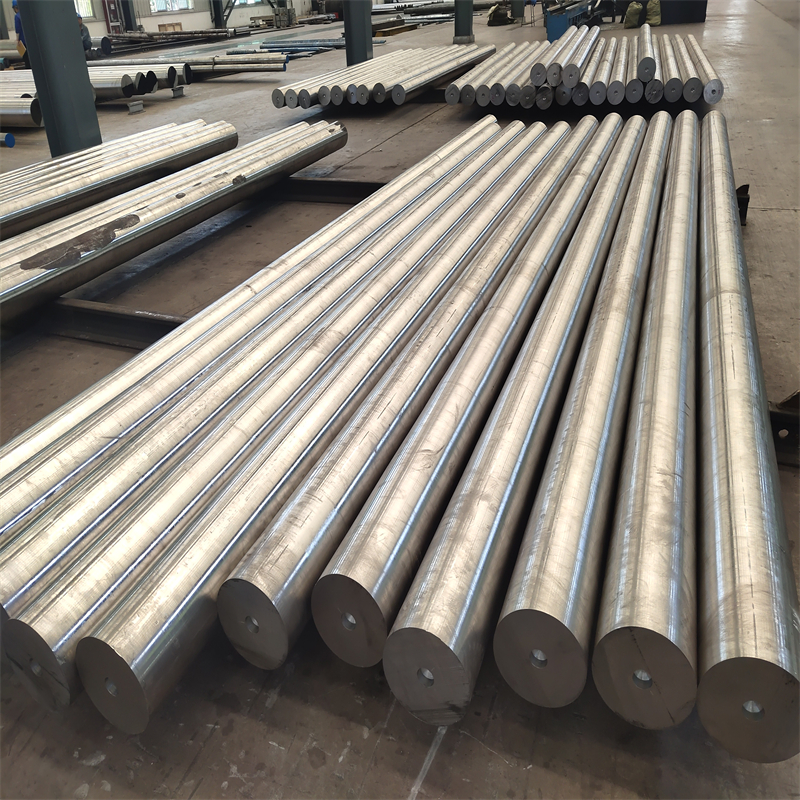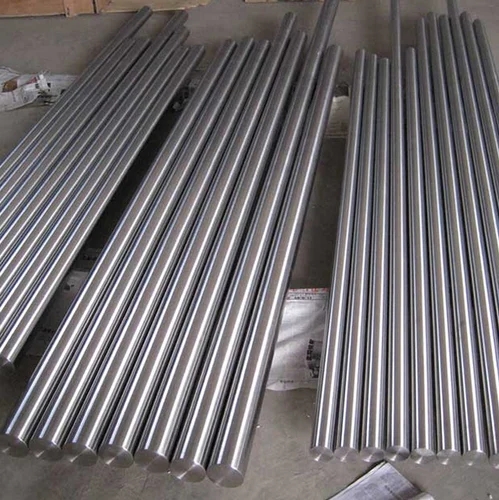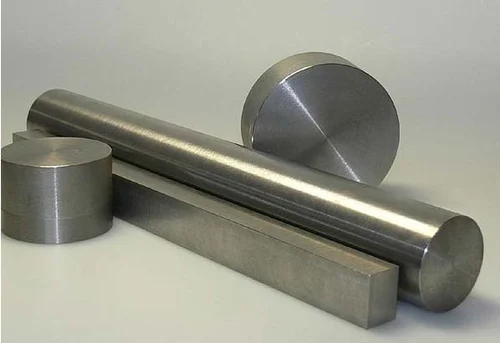A Guide To Titanium Grade 5
What is Ti Gr5 (Gr5, Titanium Grade 5, Ti-6Al-4V) Material?
Ti Gr5, commonly known as Grade 5 titanium or Ti-6Al-4V, is a titanium alloy produced in accordance with the ASTM B265 standard. The chemical composition of Ti Gr5 alloy includes 90% titanium, 6% aluminum, and 4% vanadium. This alloy is the most widely used type of titanium. Ti Gr5 titanium is often preferred in various applications due to its high strength, low density, and corrosion resistance. In addition to these properties, Ti Gr5 provides good wear resistance.
Thanks to its mechanical properties, Ti Gr5 titanium maintains the advantages of high strength and low density, while also offering better wear resistance. The alloy can be heat-treated to further enhance its strength.
Titanium Grade 5 is one of the most popular and widely used titanium alloy grades. This grade of titanium offers a combination of excellent strength, toughness, and corrosion resistance. Ti6Al4V is also resistant to many acids, has good heat resistance, and is easy to work with. Let’s dive into why this grade of titanium is so popular and explore its versatile properties in greater detail.
Titanium Grade 5 Specifications
UNS: R56400
AMS Standard: 4928
ASTM Standard: F1472
ASTM Standard: B265 Grade 5
Titanium 6Al-4V Grade 5 Round Bar Specifications:
AMS 2631, AMS 4928, AMS 4965, AMS 6930, AMS 6931, AMS-T-9047
ASTM B348
ASME SB-381
Titanium 6Al-4V Grade 5 Rectangular Bar Specifications:
AMS 4928, AMS 4965, AMS 6930, AMS 6931, AMS-T-9047
ASTM B348
Titanium 6Al-4V Grade 5 Plate Specifications:
AMS 2631, AMS 4911, AMS-T-9046
ASTM B265 Gr 5
EN 10204 3.1
Titanium 6Al-4V Grade 5 Sheet Specifications:
AMS 4911, AMS-T-9046
ASTM B265 Gr 5, ASTM F1472
EN 10204 3.1
Titanium 6Al-4V Grade 5 Block Specifications:
AMS 4928, AMS 6931, AMS-STD-9047
ASTM B348
Titanium Grade 5 Chemical Composition
| V | Al | Fe | O | C | N | H | Y | Ti | Remainder Each | Remainder Total | |
| Min | 3.5 | 5.5 | — | — | — | — | — | — | — | — | — |
| Max | 4.5 | 6.75 | 0.3 | 0.2 | 0.08 | 0.05 | 0.015 | 0.005 | Balance | 0.1 | 0.3 |
Titanium Grade 5 Physical Properties
| Property | Typical Value |
| Density g/cm3 (lb/ cu in) | 4.42 (0.159) |
| Melting Range °C±15°C (°F) | 1649 (3000) |
| Specific Heat J/kg.°C (BTU/lb/°F) | 560 (0.134) |
| Volume Electrical Resistivity ohm.cm (ohm.in) | 170 (67) |
| Thermal Conductivity W/m.K (BTU/ft.h.°F) | 7.2 (67) |
| Mean Co-Efficient of Thermal Expansion 0-100°C /°C (0-212°F /°F) | 8.6×10-6 (4.8) |
| Mean Co-Efficient of Thermal Expansion 0-300°C /°C (0-572°F /°F) | 9.2×10-6 (5.1) |
| Beta Transus °C±15°C (°F) | 999 (1830) |
Titanium Grade 5 Mechanical Properties
| Property | Minimum | Typical Value |
| Tensile Strength MPa (ksi) | 897 (130) | 1000 (145) |
| 0.2% Proof Stress MPa (ksi) | 828 (120) | 910 (132) |
| Elongation Over 2 Inches % | 10 | 18 |
| Reduction in Area % | 20 | |
| Elastic Modulus GPa (Msi) | 114 (17) | |
| Hardness Rockwell C | 36 | |
| Specified Bend Radius <0.070 in x Thickness | 4.5 | |
| Specified Bend Radius >0.070 in x Thickness | 5 | |
| Welded Bend Radius x Thickness | 6 | |
| Charpy, V-Notch Impact J (ft.lbf) | 24 (18) |
Titanium Grade 5 Uses
Titanium grade 5 is an incredibly versatile metal, offering a wide range of possibilities for applications. It has become a popular choice in engineering and manufacturing due to its high strength-to-weight ratio, corrosion resistance, high thermal stability, and ease of fabrication. Common ways this material is utilized include aerospace applications, automotive components, medical implants, prosthetics and orthotics, architecture projects such as sculptures or railings, tools used in the oil industry and marine environments, and cycling frames and components. Titanium grade 5 offers durability and survivability, allowing it to excel in different problematic conditions for long periods of time. This reliable material has revolutionized many areas as it continues to be highly sought after due to its increasingly diverse uses.
Titanium Gr 5 Rod Production
Titanium Grade 5 Applications
Implants and prostheses (wrought, cast or by additive manufacturing (AM))
Additive manufacturing
Parts and prototypes for racing and aerospace industry. Used extensively within the Boeing 787 aircraft.
Apple iPhone 15 Pro (Max)
DangleBongs
Titanium Grade 5 Corrosion Resistance
One of the reasons why Titanium Grade 5 is so popular is because it offers excellent corrosion resistance in both natural environments and industrial environments. In natural environments like seawater, it can withstand exposure for extended periods without any significant damage or corrosion. In industrial environments, such as those exposed to hydrochloric acid, sulfuric acid, and nitric acid, it exhibits superior corrosion resistance when compared to other metals.
Titanium Grade 5 Heat Resistance
Titanium Grade 5 also has an impressive ability to withstand high temperatures without becoming weakened or deformed. It can be used in applications that require long-term exposure to temperatures up to 600°F (316°C). Additionally, this grade of titanium does not become brittle at low temperatures as some other metals do.
Titanium Grade 5 Heat Treatment
Titanium Grade 5 can be heat treated for improved strength and increased hardness levels. The process involves heating the material to a specific temperature and then cooling it at a specified rate to achieve the desired results. Heat treatment can make the metal more suitable for certain applications by increasing its strength and hardness while still retaining its excellent corrosion resistance properties.
Titanium Grade 5 Machining & Welding
Titanium Grade 5 is relatively easy to machine due to its ductile nature; however, it should be machined with high-speed steel tools rather than carbide tools due to its tendency to work harden quickly during machining operations. This grade of titanium can also be welded using various methods, such as gas tungsten arc welding (GTAW) or gas metal arc welding (GMAW). However, special precautions should be taken when welding this grade of titanium due to its tendency for brittle welds if proper practices are not followed.
Titanium Grade 5 (Ti-6Al-4V) is the most common and versatile titanium alloy.ti6al4v It offers significantly higher strength than other commercially pure titanium whilst retaining good stiffness and thermal properties (excluding thermal conductivity).ti6al4v Ti-6Al-4V is widely used for components in Aerospace, Medical, Marine and Chemical Processing applications.
Ti-6Al-4V is produced by a wide range of manufacturing methods including forging, casting and rolling.ti6al4v These traditional manufacturing processes produce bulk feedstock materials that are then machined to final shapes and dimensions.ti6al4v This inevitably leads to large material waste and high manufacturing costs. The adoption of additive manufacturing (AM) technologies such as laser direct deposition (LDD) can help reduce the cost of Ti-6Al-4V parts by replacing the need for expensive machining operations.
X-ray tomography examination of DED Ti-6Al-4V samples reveals a typical microstructure with columnar b grains extending over multiple layer cross-sections.ti6al4v These b-grains are taller than the thickness of the layer and are typically formed by nucleation on top of re-melted regions from prior layers.ti6al4v The b-grains are surrounded by small pores of similar size that contribute to the porosity observed in LDD Ti-6Al-4V.
The room temperature tensile stress-strain curves of DED Ti-6Al-4V and Ti-6Al-4V+Nb in the as-built state are shown in Figure 1.ti6al4v Both demonstrate excellent ductility with a large elastic limit.ti6al4v The tensile strength of Ti-6Al-4V can be further improved by heat treatment. However, this is at the expense of fracture toughness.
Ti-6Al-4V has good resistance to corrosion in air and most chemicals, but is susceptible to hot salt stress corrosion cracking.ti6al4v It is generally attacked by environments that cause breakdown of the protective oxide, such as hydrofluoric acid (HF), hydrogen chloride (HCl) and sulfuric acid.ti6al4v It is also resistant to pure and most chlorinated hydrocarbons.
In the annealed condition, Ti-6Al-4V is very strong and tough.ti6al4v The tensile properties can be improved by solution heat treatment and subsequent aging.ti6al4v This is often performed in order to improve the tensile strength at the expense of yield strength and elongation.
Machineability of Ti-6Al-4V is a concern for some applications as it has poor shear strength and surface wear properties.ti6al4v It is hard to cut with conventional cutting tools and requires specialized equipment and lubrication. Welding of Ti-6Al-4V is difficult and requires extensive pre-heating.
Heat treatment of Ti-6Al-4V
Mill anneal, duplex anneal, and solution treatment and aging heat treatment processes for Ti-6Al-4V. Exact times and temperatures will vary by manufacturer.
Ti-6Al-4V is heat treated to vary the amounts of and microstructure of alpha and beta phases in the alloy. The microstructure will vary significantly depending on the exact heat treatment and method of processing. Three common heat treatment processes are mill annealing, duplex annealing, and solution treating and aging.
Comparing Grade 9 Titanium vs. Grade 5 Titanium Characteristics
For decades Grade 5, 6-4 titanium has dominated the titanium discussion when it comes to manufacturing applications, mainly due to the extensive use of this workhorse alloy for military and advanced aerospace applications. Grade 5 Titanium documentation abounds and since it has traditionally been the most commercially available titanium alloy it’s more well known. What isn’t so well known is the fact that while Grade 5 Titanium alloy is twice as strong its low formability makes it twice as hard to work with than Grade 9 Titanium. While both alloys are excellent, Grade 5 Titanium isn’t always the best titanium choice for cost-effective, precision production applications in the aerospace, automotive, medical, oil, gas, and power generation industries.
Grade 9 Titanium (3-2.5) is frequently the superior choice for a wide range of applications in industries across the board, perfectly suitable for producing high-tech products ranging from medical pacemakers to aerospace honeycomb.
Titanium Grade 9’s mechanical properties offer much more strength than commercially pure titanium. One of the main benefits of this Titanium alloy with 3% Aluminum, 2.5% Vanadium is that it can be cold worked, unlike Ti-6-4,
resulting in good ductility, moderately high strength, and excellent resistance to corrosion.
Both Grade 5 and Grade 9 are alpha-beta titanium alloys with 90% of their alloy composition in common but when production, labor, and manufacturing costs are considered there are distinct differences. Both are superior metals with excellent strength and corrosion-resistant characteristics. Using Ti 6-4 when Ti 3-2.5 alloy can easily meet your component specifications can most definitely have a negative impact on your bottom line. Application is always the determining factor when it comes to making the choice between Grade 5 or Grade 9 titanium.
Welding titanium in either grade can be a difficult process, requiring a specific atmosphere and advanced techniques such as MIG, TIG, plasma arc, and electron beam. NASA has a 217-page document Welding Procedures For Titanium and Titanium Alloys which details the current state of the art which includes pre-weld cleaning, post-weld cleaning and operations, and joint design. The inherent manufacturing costs and technical precision required for working with titanium makes it imperative that the most cost-effective grade is used whenever the application permits and for many applications that grade is Titanium 3-2.5.
How is Ti6Al4V G5 used in 3D printing?
Titanium alloys like Ti64-G5 are commonly low in elastic modulus and thermal conductivity, which makes them difficult to machine. In fact, titanium alloys have approximately a 50% lower elastic modulus and an 80% lower thermal conductivity than those of steel.
Those properties, alongside their high chemical reactivity, dynamic shear strength, and high hot hardness, make titanium alloys difficult to work with using traditional manufacturing methods. Challenges such as springback, high heat stress, chip thickness variation, high pressure loads, and residual stress are issues traditional manufacturing has to deal with when machining titanium alloys. As a result, wear in manufacturing tools increases, and the machined surface integrity of the part worsens, not to mention the chemical reactivity that can take place between various cutting tool materials and titanium alloys.
That is why additive manufacturing (AM) of titanium alloys has emerged as a robust and reliable solution to circumvent such challenges and minimize the subtractive steps of traditional manufacturing to create parts with near-net-shapes. Furthermore, AM allows for designing complex geometries and reducing material waste.
It all starts with having Ti6Al4V alloy in powder form. This can be achieved using gas atomization or plasma atomization. Both procedures result in spherical particles of Ti6Al4V that are ready to be 3D printed. But it is important to know which procedure is used as it defines the particle size and characteristics of the powder, which eventually determines the printed part’s properties.
3D printing methods for manufacturing Ti6Al4V Grade 5
Ti6Al4V Grade 5 can be 3D printed using DMLS, SLM, LMD, or EBM techniques. DMLS and SLM are two methods referred to as powder bed fusion (PBF) methods.
A PBF method typically applies a high-energy laser onto a metal powder bed to selectively fuse the particles and create a predesigned 3D shape. PBF is commonly used in manufacturing titanium-based parts. Its inert chamber environment enables fabrication without the risk of oxidation, a common issue in titanium manufacturing due to its titanium’s affinity to oxygen.
Nonetheless, one limitation of PBF is the relatively small part dimensions compared to other laser-based AM methods. Still, it is quite suitable for manufacturing small pieces, such as spare parts or medical devices. Furthermore, the particle size has to be specifically small and uniform (< 40 µm), increasing the manufacturing costs. And since the laser selectively hits specific areas of the powder bed, the remaining portion of the powder goes unused to be recycled and reused in future manufacturing trials.
LMD, on the other hand, is usually used when working on parts of larger sizes, especially for cases of repairing, surface coating, or adding new part features. LMD also makes use of a laser source but not in a similar way to PBF. Here, the laser source hits the surface of a base material to create a melt pool on that metal surface. Then, titanium alloy powder is deposited into the melt pool using a gas stream – thus the name laser metal deposition.
This method minimizes the amount of powder used and allows for larger particle sizes (40 – 150 µm). However, the environment here is not inert, subjecting the material to potential oxidation. That is why inert gas is introduced to the processing area using a nozzle. That being said, other challenges can arise here, including heat evacuation, surface temperature control, and geometric obstructions. Since the supply of inert gas moves as the processing area moves, considerations should be taken to avoid those challenges.
EBM is quite similar to SLM (a PBF method) in its working principle. The main difference, though, is the high-energy source used to fuse the metal powder. Instead of a laser, EBM uses a high-energy electron beam. This beam is supported by two magnetic fields that narrow down the beam’s diameter and navigate it towards the desired target points on the powder bed. The electron bombardment converts the kinetic energy into thermal energy, raising the powder’s temperature beyond its melting point, where selective fusion begins to take place. A distinct characteristic of EBM is its high manufacturing speed; however, it usually has lower accuracy and finish quality than SLM.
What is the Price of Ti Gr5 (Gr5, Titanium Grade 5) Material?
The price of Ti Gr5 (Gr5, Titanium Grade 5) material varies depending on the product section, dimensions, and surface quality.
Titanium Grade 5 Manufacturer
Welcome to our of titanium 5 production! As a leading manufacturer based in China, we take pride in delivering top-quality titanium 5 products to meet your diverse needs. Whether you are in the coatings, plastics, or paper industry, our commitment to excellence ensures that you receive the finest titanium dioxide for your applications.
Our state-of-the-art facilities are equipped with cutting-edge technology and adhere to the highest industry standards. We prioritize quality control at every stage of the production process, ensuring that our titanium dioxide not only meets but exceeds your expectations.
>>Inquiry Now<<





